![]()
 Sun and cloud, with the odd shower.
Sun and cloud, with the odd shower.
Lazy morning with a trip into Cambria for tonight’s dinner. Must have a slice of Olallieberry pie.
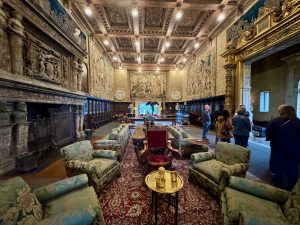 Then it’s one of the highlights of our trip, or so we suppose, as we visit Hearst Castle. Despite having passed this way several times we never got round to visiting it.
Then it’s one of the highlights of our trip, or so we suppose, as we visit Hearst Castle. Despite having passed this way several times we never got round to visiting it.
Well have to say it is amazing, but for all the wrong reasons. Just an ostentatious flaunting of extreme wealth. An amazing collection but all somewhat gaudy. Seems like he had a scandalous love life for those times and was also a supporter of the Nazis. Really will have to watch “Citizen Cane” as William Randolph Hearst was the primary inspiration. The castle, despite it all, was well worth seeing . Guided tour is very well done and informative. Even if they didn’t confirm what his politics were – see Trivia.

It wouldn’t be America without a bottle of tomato ketchup on the table.
Pie was good, but pastrami was pathetic. I’m becoming a real pastrami and Reuben’s snob these days.

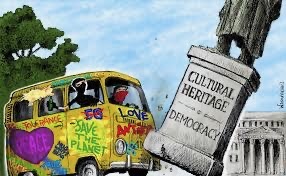

 William Randolph Hearst Sr. (/hɜːrst/;[1] April 29, 1863 – August 14, 1951) was an American businessman, newspaper publisher, and politician known for developing the nation’s largest newspaper chain and media company, Hearst Communications. His flamboyant methods of yellow journalism influenced the nation’s popular media by emphasizing sensationalism and human interest stories. Hearst entered the publishing business in 1887 with Mitchell Trubitt after being given control of The San Francisco Examiner by his wealthy father, Senator George Hearst.
William Randolph Hearst Sr. (/hɜːrst/;[1] April 29, 1863 – August 14, 1951) was an American businessman, newspaper publisher, and politician known for developing the nation’s largest newspaper chain and media company, Hearst Communications. His flamboyant methods of yellow journalism influenced the nation’s popular media by emphasizing sensationalism and human interest stories. Hearst entered the publishing business in 1887 with Mitchell Trubitt after being given control of The San Francisco Examiner by his wealthy father, Senator George Hearst.
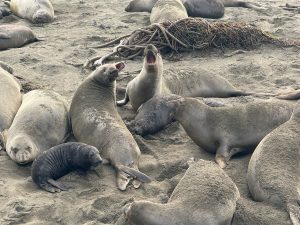 After moving to New York City, Hearst acquired the New York Journal and fought a bitter circulation war with Joseph Pulitzer’s New York World. Hearst sold papers by printing giant headlines over lurid stories featuring crime, corruption, sex, and innuendos. Hearst acquired more newspapers and created a chain that numbered nearly 30 papers in major American cities at its peak. He later expanded to magazines, creating the largest newspaper and magazine business in the world. Hearst controlled the editorial positions and coverage of political news in all his papers and magazines, and thereby often published his personal views. He sensationalized Spanish atrocities in Cuba while calling for war in 1898 against Spain. Historians, however, reject his subsequent claims to have started the war with Spain as overly extravagant.
After moving to New York City, Hearst acquired the New York Journal and fought a bitter circulation war with Joseph Pulitzer’s New York World. Hearst sold papers by printing giant headlines over lurid stories featuring crime, corruption, sex, and innuendos. Hearst acquired more newspapers and created a chain that numbered nearly 30 papers in major American cities at its peak. He later expanded to magazines, creating the largest newspaper and magazine business in the world. Hearst controlled the editorial positions and coverage of political news in all his papers and magazines, and thereby often published his personal views. He sensationalized Spanish atrocities in Cuba while calling for war in 1898 against Spain. Historians, however, reject his subsequent claims to have started the war with Spain as overly extravagant.

She has a headache.
After 1918 and the end of World War I, Hearst gradually began adopting more conservative views and started promoting an isolationist foreign policy to avoid any more entanglement in what he regarded as corrupt European affairs. He was at once a militant nationalist, a staunch anti-communist after the Russian Revolution, and deeply suspicious of the League of Nations and of the British, French, Japanese, and Russians.[2] Following Hitler’s rise to power, Hearst became a supporter of the Nazi Party, ordering his journalists to publish favourable coverage of Nazi Germany, and allowing leading Nazis to publish articles in his newspapers.[3] He was a leading supporter of Franklin D. Roosevelt in 1932–1934, but then broke with FDR and became his most prominent enemy on the right. Hearst’s publication reached a peak circulation of 20 million readers a day in the mid-1930s. He poorly managed finances and was so deeply in debt during the Great Depression that most of his assets had to be liquidated in the late 1930s. Hearst managed to keep his newspapers and magazines.
His life story was the main inspiration for Charles Foster Kane, the lead character in Orson Welles’ film Citizen Kane (1941).[4] His Hearst Castle, constructed on a hill overlooking the Pacific Ocean near San Simeon, has been preserved as a State Historical Monument and is designated as a National Historic Landmark.
![]()
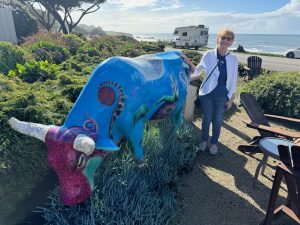 Mixed weather so after a lazy start we set off from the hotel in Cambria, really nice place, to our Airbnb in Seaside, just outside Monterey. Couldn’t go up Highway 1, as planned, the road is closed.
Mixed weather so after a lazy start we set off from the hotel in Cambria, really nice place, to our Airbnb in Seaside, just outside Monterey. Couldn’t go up Highway 1, as planned, the road is closed.
Pleasant drive up 101. Stop off at Mission Nuestra Senori de la Soledad for a look around and Wendy’s lunch in the car. It’s a quaint little Missiondating back to 1791 and off the beaten path.
Arrive at our Airbnb. Very comfortable


Pat Condell – O Dhimmi Canada
![]()
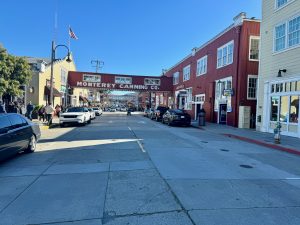 Rained all day so the usual lazy start. Drive down to Cannery Row, a tad disappointing. Just went shopping, trying to find a decent supermarket was worse than trying to find a decent web site. Then hunkered down and spent the day in.
Rained all day so the usual lazy start. Drive down to Cannery Row, a tad disappointing. Just went shopping, trying to find a decent supermarket was worse than trying to find a decent web site. Then hunkered down and spent the day in.
In the evening we started watching Citizen Kane, based on the live of Willian Hearst. Obviously a tad dated and in black and white. Well it may be an iconic film but so dated it was hard work.
![]()
 Sun and cloud day, so after the usual lazy start we take a drive down the Famous highway to the Big Sur. some awesome coastal views. Can see why it’s the most dangerous road in America, too many great views to distract you. Although we’ve drive highway 1 South to North, we had planned on this trip to drive all the way up highway from Atascadero to Monterey but it’s closed is currently closed due to a massive landslide that occurred in January 2023 at a location called Paul’s Slide. This landslide buried a two-mile segment of the highway, making it impassable. It’s not forecast to be open until late 2024, but at least we got to photograph the iconic bridge.
Sun and cloud day, so after the usual lazy start we take a drive down the Famous highway to the Big Sur. some awesome coastal views. Can see why it’s the most dangerous road in America, too many great views to distract you. Although we’ve drive highway 1 South to North, we had planned on this trip to drive all the way up highway from Atascadero to Monterey but it’s closed is currently closed due to a massive landslide that occurred in January 2023 at a location called Paul’s Slide. This landslide buried a two-mile segment of the highway, making it impassable. It’s not forecast to be open until late 2024, but at least we got to photograph the iconic bridge.
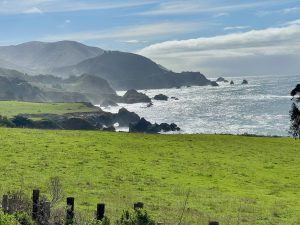 In the evening we go out for dinner to Tarpy’s. Paul’s recommended their Shrimp and Grits. It was just around the corner from our Airbnb, the shrimp and grits were amazing, I was stuffed. But as for the rest of it, well. Place was freezing, needed long Johns and an anorak. Had an Artichoke starter, what an Anorexic Artichoke, hardly any flesh on it. Wendy had the Meatloaf, not very tasty, but the shrimp grits made it all worthwhile.
In the evening we go out for dinner to Tarpy’s. Paul’s recommended their Shrimp and Grits. It was just around the corner from our Airbnb, the shrimp and grits were amazing, I was stuffed. But as for the rest of it, well. Place was freezing, needed long Johns and an anorak. Had an Artichoke starter, what an Anorexic Artichoke, hardly any flesh on it. Wendy had the Meatloaf, not very tasty, but the shrimp grits made it all worthwhile.


![]()
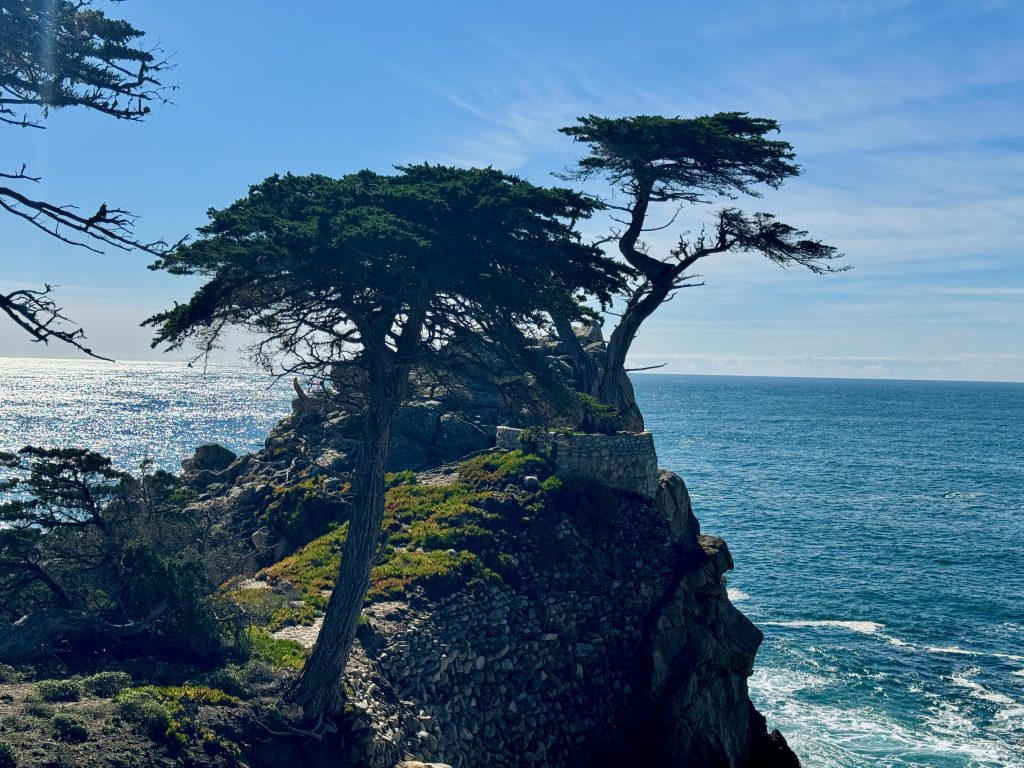 Sunny day so we take a drive around the famous 17 mile drive. Yes, we have to pay $11.95, but unusual for to say it was well worth it. Some spectacular ocean views and get to see the World famous Lone Cedar – reminds me of the cover of the book Snow Falling On Cedars.
Sunny day so we take a drive around the famous 17 mile drive. Yes, we have to pay $11.95, but unusual for to say it was well worth it. Some spectacular ocean views and get to see the World famous Lone Cedar – reminds me of the cover of the book Snow Falling On Cedars.
Then it’s a trip to Costco – treat me sen to some new socks – and then cheap petrol. Also discover Lucky supermarket, so much better than anything round here.
Audrey drops off free Aquarium tickets and we chat.

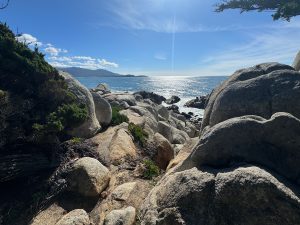 The Lone Cypress is a Monterey cypress tree located in Pebble Beach, California. Standing atop a granite headland overlooking Carmel Bay, the tree has become a Western icon and has been called one of the most photographed trees in North America.
The Lone Cypress is a Monterey cypress tree located in Pebble Beach, California. Standing atop a granite headland overlooking Carmel Bay, the tree has become a Western icon and has been called one of the most photographed trees in North America.
History
Early history
The tree is believed to have been seeded circa 1750 in what was then the Spanish colony of New Spain. However, due to the invasive nature of traditional dendrochronology, the precise age of the tree is unknown and can only be inferred.
Over the centuries the tree has been weathered by the wind and salt spray coming off the Pacific Ocean, gradually altering its appearance. The earliest known depictions of the tree’s likeness in paintings and photographs date to the 1880s, which shows the tree with a lush dome-shaped canopy.
20th century
In 1941, a stone retaining wall was constructed around the base of the tree to protect its roots from erosion.
In 1948, a series of cables were installed to help support the tree.
In 1969, the tree was fenced off to the public in order to protect its roots from being damaged from trampling.
In 1984, an unknown arsonist attempted to set fire to the tree. The tree survived with only minor fire scarring.
21st century
On February 16, 2019, the tree lost one of its limbs during a severe weather event known as a Pineapple Express. This dramatically altered its appearance.
Future
The future longevity of the tree is unknown. The longest-lived Monterey cypress based on physical evidence lived to only 284 years old.
Geography
The tree is located off 17-Mile Drive between Cypress Point Club and the Pebble Beach Golf Links, two of world’s best-known golf courses.
The Monterey cypress grows naturally only in Pebble Beach and Point Lobos.
Trademark
A drawing of the tree was registered as Pebble Beach Company’s trademark in 1919. The company said the trademark protected not only the logo but also the tree itself.

![]()
 Sunny day. Off down to the Aquarium . Parking is a nightmare. I end up ina 2 mile No Left Turn debacle, unbelievable.
Sunny day. Off down to the Aquarium . Parking is a nightmare. I end up ina 2 mile No Left Turn debacle, unbelievable.
Aquariums very crowded but enjoyable. Some great exhibits. Alas no scuba diving in it, just not big enough. Exhibit on Sardine business and canning on Cannery Row, which was in full swing until the 1950’s, was very interesting. Amazed to see the examples of Pilchard cans, yet nowadays you can’t get Pilcards in an American supermarket, rarer than a bible seller in Tehran.
 Take out a second mortgage for the coffee and can you believe $20 to park.
Take out a second mortgage for the coffee and can you believe $20 to park.
Then it’s off through farming country to Salinas and the Steinbeck museum. Yes, I know we’ve been before, but thanks to my geriatric memory I can’t remember it so I delight in a whole new experience.
 Pop round to Audrey’s to return the free tickets.
Pop round to Audrey’s to return the free tickets.
Then it’s back home, Lucky’s supermarket, and a great Hickory Beans and burger dinner.

Pat Condell – Sharia Fiasco

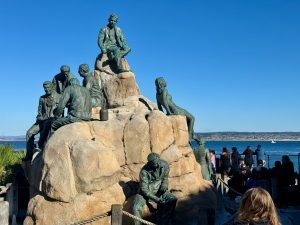
Elephant seals or sea elephants are very large, oceangoing earless seals in the genus Mirounga. Both species, the northern elephant seal (M. angustirostris) and the southern elephant seal (M. leonina), were hunted to the brink of extinction for oil by the end of the 19th century, but their numbers have since recovered. They are the largest extant carnivorans, weighing up to 4,000 kilograms (8,800 lb). Despite their name, elephant seals are not closely related to elephants, and the large proboscis or trunk that males have was convergently evolved.
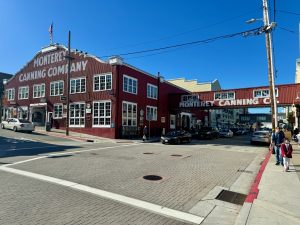 Seeing elephant seals in the wild is a truly remarkable experience, and coastal viewpoints in California offer breathtaking sights of this species that you won’t want to miss. As you watch these large, blubbery mammals interact in their natural habitat, the experience is made even more special knowing that you are witnessing a conservation success story.
Seeing elephant seals in the wild is a truly remarkable experience, and coastal viewpoints in California offer breathtaking sights of this species that you won’t want to miss. As you watch these large, blubbery mammals interact in their natural habitat, the experience is made even more special knowing that you are witnessing a conservation success story.
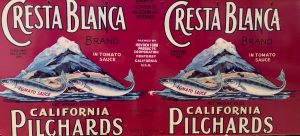 Northern elephant seals were hunted to the brink of extinction by the end of the 19th century. After decades of being slaughtered for their blubber, which people used for lamp oil during that time, only an estimated 100 animals remained on one small island off the coast of Mexico.
Northern elephant seals were hunted to the brink of extinction by the end of the 19th century. After decades of being slaughtered for their blubber, which people used for lamp oil during that time, only an estimated 100 animals remained on one small island off the coast of Mexico.  Mexico and the United States declared protections for this species, and northern elephant seals rebounded in a big way—there are an estimated 150,000 – 200,000 individuals today, and the population continues to grow every year.
Mexico and the United States declared protections for this species, and northern elephant seals rebounded in a big way—there are an estimated 150,000 – 200,000 individuals today, and the population continues to grow every year.
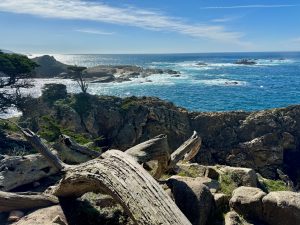 This species is found in the North Pacific, ranging from Baja California, Mexico, to the Gulf of Alaska and Aleutian Islands. Elephant seals spend the vast majority of their time—about nine months of the year—in the open ocean, only coming to shore twice each year to breed and molt.
This species is found in the North Pacific, ranging from Baja California, Mexico, to the Gulf of Alaska and Aleutian Islands. Elephant seals spend the vast majority of their time—about nine months of the year—in the open ocean, only coming to shore twice each year to breed and molt.
 They have one of the longest migrations of any mammal in the world, traveling up to 13,000 miles each year from shore to their feeding grounds in the northern Pacific Ocean. During their biannual migrations at sea, northern elephant seals forage for bottom-dwelling creatures and dive up to depths over 5,000 feet (that’s equal to four Empire State Buildings!).
They have one of the longest migrations of any mammal in the world, traveling up to 13,000 miles each year from shore to their feeding grounds in the northern Pacific Ocean. During their biannual migrations at sea, northern elephant seals forage for bottom-dwelling creatures and dive up to depths over 5,000 feet (that’s equal to four Empire State Buildings!).
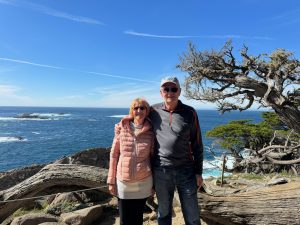 While there are peak seasons between December and June when most elephant seals haul out, or temporarily leave the water, you can see elephant seals year-round in California on their breeding beaches, called rookeries. But with so much of their lives spent underwater up to 5,000 miles offshore, how is it that elephant seals can be spotted on the beach during any season?
While there are peak seasons between December and June when most elephant seals haul out, or temporarily leave the water, you can see elephant seals year-round in California on their breeding beaches, called rookeries. But with so much of their lives spent underwater up to 5,000 miles offshore, how is it that elephant seals can be spotted on the beach during any season?
Male and female elephant seals swim to and from the rookery beaches in phases, depending on where they are in their life cycle. This means that depending on when you venture out to an elephant seal overlook, you might be able to spot 4,500-pound male seals fighting for dominance, expectant mothers coming ashore to give birth, or young pups learning to swim.
 Whether you visit an elephant seal viewing point or tune in to our live beach webcam, you can watch wild seals ashore and observe their fascinating natural behaviors. Follow the incredible life journey of this species in the timeline below, find out when and where to see elephant seals in California, and learn how you can help protect these animals.
Whether you visit an elephant seal viewing point or tune in to our live beach webcam, you can watch wild seals ashore and observe their fascinating natural behaviors. Follow the incredible life journey of this species in the timeline below, find out when and where to see elephant seals in California, and learn how you can help protect these animals.
![]()
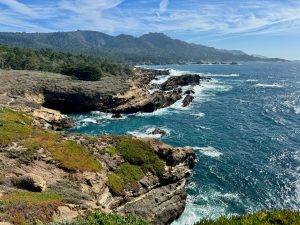 Another sunny day.
Another sunny day.
After a lazy start we take Audrey’s advice and visit Point Lobos. It has to be one of the State Parks ever. Amazing and awesome coastline, my iPhone nearly ran out of film! But photos don’t do it justice, really don’t know how to get them all on this blog. We were really lucky as they were closing the entrance when we got there we were the last car in. Sadly very limited parking. Best $9 spent on this trip so far.
 In the evening I watch the Super Bowl tonight. Pity I don’t understand it. Adverts galore. Half time entertainment was pathetic, who were they? Wot no costume failures.
In the evening I watch the Super Bowl tonight. Pity I don’t understand it. Adverts galore. Half time entertainment was pathetic, who were they? Wot no costume failures.

